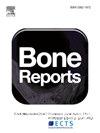Effects of 650 nm laser acupuncture on cartilage, bone, and skeletal muscle in osteoarthritis
IF 2.6
Q3 ENDOCRINOLOGY & METABOLISM
引用次数: 0
Abstract
This study evaluated the therapeutic effects of 650 nm laser acupuncture at 10 mW and 20 mW in a monosodium iodoacetate (MIA) induced osteoarthritis (OA) rat model. OA was induced by intra-articular injection of MIA, and laser acupuncture was applied to GB34 and GB39 twice weekly for four weeks. Cartilage preservation was assessed by Safranin-O staining, pain by hind paw weight distribution, bone structure by micro-CT analysis of bone volume fraction, trabecular volume, and cortical thickness, and muscle condition by histology and wet weight of the gastrocnemius and quadriceps. Both laser treatments reduced cartilage degeneration and improved weight-bearing. The 10 mW group showed greater improvements than the 20 mW group, including higher proteoglycan content, better bone structural parameters, and greater muscle mass. These results indicate that 10 mW laser acupuncture is more effective than 20 mW in reducing joint damage and preserving musculoskeletal tissue. The findings support the use of low-power laser acupuncture as a non-invasive treatment for OA. The study also shows that higher laser power does not necessarily lead to better outcomes, highlighting the need for appropriate dose selection. Further studies are needed to assess long-term effects and investigate underlying mechanisms.
650nm激光针刺对骨关节炎软骨、骨和骨骼肌的影响
研究了10 mW和20 mW 650 nm激光针刺对碘乙酸钠(MIA)诱导的骨关节炎(OA)大鼠模型的治疗作用。采用MIA关节内注射诱导OA,激光针刺GB34、GB39,每周2次,连续4周。采用Safranin-O染色评估软骨保存情况,采用后爪重量分布评估疼痛情况,采用显微ct分析骨体积分数、骨小梁体积和骨皮质厚度评估骨结构,采用腓肠肌和股四头肌的组织学和湿重评估肌肉状况。两种激光治疗都能减少软骨变性并改善负重。与20 mW组相比,10 mW组表现出更大的改善,包括更高的蛋白聚糖含量、更好的骨结构参数和更大的肌肉质量。这些结果表明,10mw激光针刺在减轻关节损伤和保护肌肉骨骼组织方面比20mw更有效。研究结果支持使用低功率激光针灸作为OA的非侵入性治疗。该研究还表明,更高的激光功率不一定会带来更好的结果,强调了适当剂量选择的必要性。需要进一步的研究来评估长期影响和调查潜在的机制。
本文章由计算机程序翻译,如有差异,请以英文原文为准。
求助全文
约1分钟内获得全文
求助全文
来源期刊

Bone Reports
Medicine-Orthopedics and Sports Medicine
CiteScore
4.30
自引率
4.00%
发文量
444
审稿时长
57 days
期刊介绍:
Bone Reports is an interdisciplinary forum for the rapid publication of Original Research Articles and Case Reports across basic, translational and clinical aspects of bone and mineral metabolism. The journal publishes papers that are scientifically sound, with the peer review process focused principally on verifying sound methodologies, and correct data analysis and interpretation. We welcome studies either replicating or failing to replicate a previous study, and null findings. We fulfil a critical and current need to enhance research by publishing reproducibility studies and null findings.
 求助内容:
求助内容: 应助结果提醒方式:
应助结果提醒方式:


